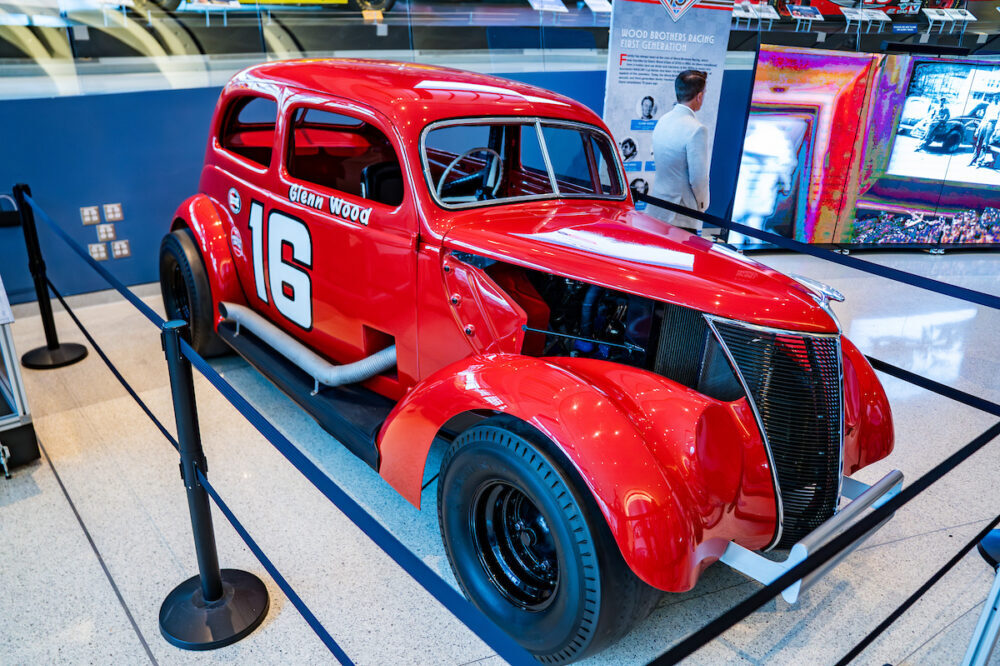Mark Martin’s 1998 Ford Taurus
by Tom Jensen May 10, 2021
The 1998 season saw a rare instance where NASCAR allowed a manufacturer to compete with a car it never actually sold.

With the Thunderbird discontinued, Ford took the radical step of going NASCAR racing with the four-door Taurus sedan, but with a heavily modified body that looked like a sports coupe. Photo courtesy of David Taylor/Allsport
The NASCAR Hall of Fame’s current Great Hall exhibit, “A Legendary Decade: The First 50 Inductees,” honors the 50 individuals voted into the Hall of Fame in the first 10 classes, from 2010-2019. Each of the inductees is recognized in their respective class, and each of the classes is represented by one car.
All 10 cars have unique stories to tell, and some are a little more unique than others.
Take, for instance, the 1998 Ford Taurus campaigned by Hall of Famer Mark Martin (2017) for Roush Racing (now Roush Fenway Racing).

Mark Martin won a career-high seven races in the first year of the Ford Taurus in NASCAR. Photo courtesty of David Taylor/Allsport
From 1978 to 1997, the Ford Thunderbird sports coupe was Ford Motor Co.’s primary weapon in NASCAR premier series competition, winning 176 races during that time.
Bill Elliott (2015) won the 1988 championship driving a Thunderbird and so did Alan Kulwicki four years later, though Kulwicki chopped the “Th” of the nose of his car so it became known as the Underbird.
Thunderbirds also powered Ford Motor Co. to NASCAR manufacturers’ championships in 1992, ’94 and ‘97.
But then two events changed Ford’s plans.

One of Mark Martin’s biggest victories in 1998 came in the inaugural premier series race at Las Vegas Motor Speedway. Photo courtesy of NASCAR Archives & Research Center via Getty Images
First, in 1995, Chevrolet brought back the Monte Carlo two-door coupe, and it was instantly successful, with Hendrick Motorsports teammates and future Hall of Famers Jeff Gordon (2019) and Terry Labonte (2016) combining to win four consecutive driver championships from 1995-98.
There was another even larger factor at play: Correctly forecasting that the demand for sporty two-door coupes was declining, Ford discontinued the Thunderbird for 1998, while keeping in production its best-selling Taurus, which was available in two body styles, sedan and station wagon.

There are 10 race cars featured in “A Legendary Decade: The First 50 Inductees,” the latest Great Hall exhibit at the NASCAR Hall of Fame. Photo courtesy of Jamey Price
There was just one catch: The Taurus sedan and wagon were both four-door models. There was no two-door Taurus at all. Not before 1998, nor during or after. Ford never, ever produced and sold a two-door Taurus.
But in March 1997, Ford made the decision to race the Taurus, announcing it publicly in late July that year at the Indiana Convention Center.
Ford’s top drivers were in Indianapolis for the big announcement.
“We've been getting our butt kicked by Chevy,” Hall of Famer Rusty Wallace (2013) told reporters. “We need this car to be a good one.”
We've been getting our butt kicked by Chevy. We need this car to be a good one.
— Rusty Wallace
“It's a matter of trust, really,” added Martin. “All of the work has to get done in the shop and the wind tunnel -- 99 percent of it. The last 1 percent we'll worry about in testing.”
Team owner Jack Roush (2019), who along with Roger Penske (2019) led development of the NASCAR Taurus was not initially optimistic.
“It's got some problems,” Roush told the Orlando Sentinel. “I don't see any real strengths in the (Taurus) in terms of the NASCAR format. ... It's got four doors. The Taurus has got a tall roof with a lot of room for passengers. Four doors. It's a totally different package dimensionally than, let's say, the two-door (Chevrolet) Monte Carlo or the (Pontiac) Grand Prix.”

The 1998 Ford Taurus was a big departure for Mark Martin and the rest of the Ford drivers. Photo courtesy of Jamey Price
Roush may have underestimated his own development capabilities.
Jeff Gordon did win his second consecutive championship and third overall in 1998, but Martin finished in the runner-up slot ahead of fellow Ford drivers Dale Jarrett (2014), Wallace and Martin’s teammate, Jeff Burton.
During the ’98 season, Martin drove his Valvoline-sponsored No. 6 Ford Taurus to single-season personal bests with seven victories and 22 top fives. Martin also scored a then career-best 26 top-10 finishes, a figure he would match a year later.

Roush Racing was one of Ford’s lead development teams in adapting the Taurus to NASCAR racing. Photo courtesy of Jamey Price
Ford and its teams had a lot of work to do to make the boxy Taurus sedan into a sleek and svelte race car, but Martin and Roush proved it could be done in 1998, and in ’99 Jarrett piloted a Taurus owned by Robert Yates (2018) to a championship.
Mission accomplished.
Plan your visit to the NASCAR Hall of Fame and purchase tickets by visiting nascarhall.com/tickets.














